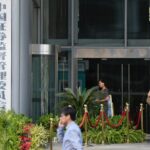The Shanghai Astronomy Museum, the world’s largest of its kind, has started trial operation to showcase humankind’s unremitting efforts throughout history to explore the universe and China’s latest achievements in space exploration.
The Foucault pendulum experiment, the spaghettification in a black hole, the theory of relativity, the Doppler effect and cosmic microwave background radiation, among a series of abstract concepts and famous experiments related to astronomy, are explained or replicated with models and experimental equipment, making astronomy more accessible and understandable.
An, a geography teacher at a local high school, mentioned that the design of the museum is very clever with the concepts of time and space contained in the exhibition. “The exhibition makes it easier for visitors, especially students, to understand the universe and astronomy through physical objects on display,” An told the Global Times on Tuesday.
Located in Lingang Area, a newly launched section of the Shanghai Free-Trade Zone, the museum occupies an area of about 58,600 square meters including a constructed area of about 38,000 square meters, making it the largest of its kind in the world.
The main body of the museum is divided into three themed sections including “home,” “cosmos” and “odyssey”, featuring the solar system, the observable universe beyond the solar system and the history of human research on astronomy and space exploration.
In 1851, the French physicist Léon Foucault successfully performed a pendulum experiment which categorically proved that the earth rotates from west to east. One of the must-see exhibits include a model of Foucault’s experiment which allows visitors to watch the pendulum slowly rotating clockwise without external force as a the result of earth’s rotation.
With an elaborately designed environment, light and sound effects, and highly accurate simulations, the museum creates an immersive experience of space for visitors, offering a brand new experience of the exploration in the universe.
A visitor to the museum surnamed Chen told the Global Times on Tuesday that she was overwhelmed by the exhibits on display since “the demonstrations of astronomy are so realistic.”
The integrated use of all kinds of cutting-edge technologies, including somatosensory interaction, data visualization, AR, VR and biometric technologies, ensures that visitors’ emotions and senses are fully aroused by the over 300 exhibits.
In the “odyssey” section, highly precise models of Chinese spacecrafts, including the Tianhe space core module, the Mars rover Zhurong, and the lunar rover Yutu II are on display to demonstrate China’s latest achievements in space exploration.
The museum has also collected more than 120 pieces or sets of precious cultural relics including original works of astronomy geniuses including the first English version of Newton’s The Mathematical Principles of Natural Philosophy published in 1729.
The museum marks a new stage in the development of the super-large comprehensive science and technology museum cluster which consists of the Shanghai Science and Technology Museum, the Shanghai Natural History Museum and the Shanghai Astronomy Museum. This fully demonstrates the soft power of Shanghai and promotes the high-quality development of the museum industry in the new era.
Models of stars and planets on display at the Shanghai Astronomy Museum Photo: Chen Xia/GT


